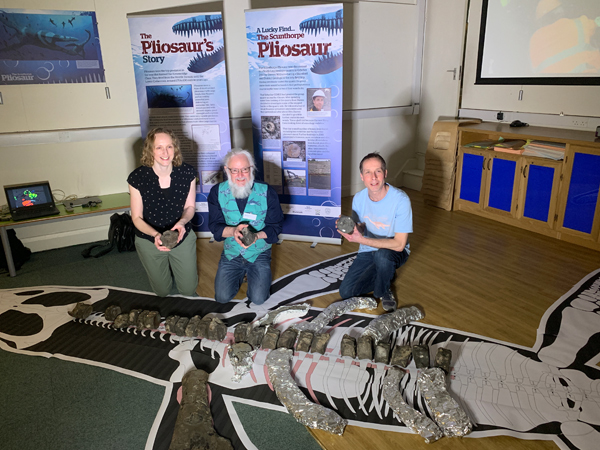The Astonishing “Scunthorpe Pliosaur”
The “Scunthorpe Pliosaur” – What is it? When and Where Did it Live? What it May Have Eaten and Lived Alongside
A few weeks ago, we set young palaeontologist Thomas a challenge, could he research and write an article for posting up onto the Everything Dinosaur blog. Thomas has taken up our offer and here is the first of his articles, it provides information on a prehistoric animal close to Thomas’s heart the “Scunthorpe Pliosaur”.
The “Scunthorpe Pliosaur”, a specimen announced earlier this year, was a large plesiosauroid belonging to the family Pliosauridae and is related to the better known pliosaurs such as Pliosaurus and Liopleurodon in fact, it may have lived alongside and directly competed with these two better-known pliosaurs at some point. It has been estimated at 8 metres long.
The “Scunthorpe Pliosaur” on Display at North Lincolnshire Museum

Picture credit: North Lincolnshire Museum
When and Where Did the “Scunthorpe Pliosaur” Live and Where was it Found?
The “Scunthorpe Pliosaur” lived around 160 to 155 million years ago in what is now north Lincolnshire (England). These fossils date from the Late Jurassic and the United Kingdom 160 million years ago was a very mysterious place. Whilst marine fauna is decently represented in the fossil record, there is still much science does not know about the seas from this time and this new specimen may help open up a new window into that mysterious world. The terrestrial fauna on the other hand, is poorly represented and full of mystery with one of the only described theropods being the British Metriacanthosaurus from Dorset (a close relative of Sinraptor from China). The pliosaur specimen was recovered from a CEMEX quarry.
What Did it Live With and What Might it Have Eaten?
Inhabiting the seas alongside the “Scunthorpe Pliosaur” were other pliosaurs, plesiosaurs, turtles, fish, ichthyosaurs, squid, ammonites, marine crocodiles, sharks and more. Some of these animals include the pliosaurs Liopleurodon, Simolestes and Pliosaurus which would have competed with it and the plesiosaurs Cryptocleidus and Colymbosaurus which could have been prey of the pliosaur especially the latter plesiosaur’s young.
Looking at the “Scunthorpe Pliosaur’s” dentition, the known teeth of this pliosaur are reminiscent of teeth associated with Pliosaurus (Pliosaurus brachydeirus), a species which has been found in Lincolnshire. From this comparison, it can be concluded that the Scunthorpe individual possibly preyed upon other marine reptiles and other large marine fauna. Stomach content of related pliosaurs and bite marks left by them on their prey show that pliosaurs like the Scunthorpe specimen would have been hunting a wide range of hard bodied marine prey from large ammonites to plesiosaurs and ichthyosaurs. However, they wouldn’t have shied away from preying on softer bodied animals.
A Powerful Sense of Smell
Like most pliosaurs, the “Scunthorpe Pliosaur” probably had a very powerful sense of smell, good eyesight, acute hearing and a powerful bite, all necessary adaptations for a hunting pliosaur to have in order to hunt effectively.
The ecology at the time would have consisted of kelp forests, reefs, coastal shallows and a steep pelagic drop-off that plummets into a benthic zone. Pliosaurs such as Liopleurodon, Pliosaurus and the “Scunthorpe Pliosaur” probably used these drop-off points as ambush spots to strike unsuspecting prey from below.
When attacking prey, pliosaurs would have come up from below like white sharks and either rammed or bitten prey in one massive disabling blow to the prey item to prevent it’s escape. In conclusion, the “Scunthorpe Pliosaur “was a large pliosaur which could have occupied the apex predator niche in its warm, shallow coastal ecosystem hunting all manners of prey from fish and squid to marine reptiles using sight, hearing and smell to track down its prey and applying similar hunting strategies to modern Great Whites to secure and catch that prey.
This discovery is an important one as it opens up a window into a little known area of the Late Jurassic British seas and helps palaeontologists piece together that ancient ecosystem over 155 million years ago.
A Model of a Typical Pliosaur
Our thanks to Thomas for compiling this article on the “Scunthorpe Pliosaur”.


